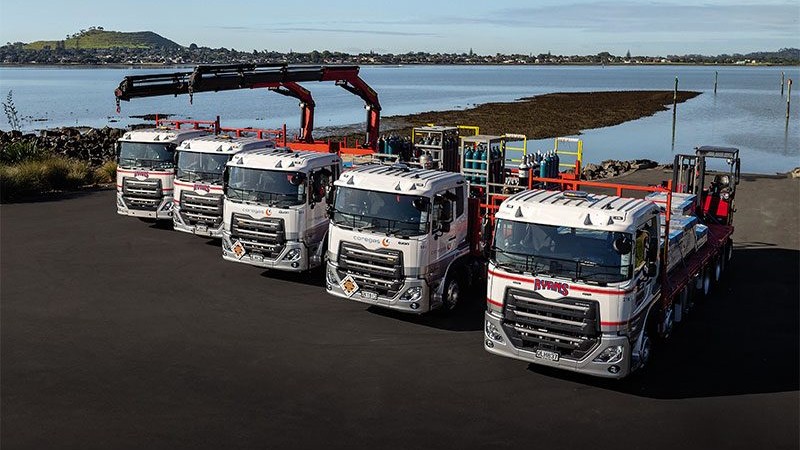
Two long-standing names in trucks and trucking have come together, proving how the right gear in the right environment can have a positive impact company-wide.
We speak about it often in the pages of New Zealand Trucking magazine: Company culture and all it encompasses within successful businesses … Enabling your people to do and be the best they can, giving your clients the highest level of service possible, and implementing the right tools and processes to do the job as efficiently and safely as possible. Every company will have a different definition and different ways of making it happen but, if done right, the results are longevity, loyalty, respect, pride and success.
So often when it comes to trucking, culture is built over decades and stems from the hard work and dedication put in by the company’s pioneers right from the beginning. Auckland’s Tom Ryan Cartage is one such company, started by Tom in 1979 and incorporated as Tom Ryan Cartage in 1985.
After 45 years in the game, Tom is still active in the business, though general manager Alan Spilhaus now coordinates day-to-day running.
“Tom comes in three or four times a week and provides valuable stewardship and guidance. Being honest, he loves the trucks, loves his workshop. He’s a truckie through and through,” says Alan. “I’m more of a bean counter – finance and money,” he adds with a laugh.
The company’s story leaves little doubt as to how its culture was formed. “It starts in 1979, with Tom and a little Bedford,” Alan explains. “Tom had worked for his dad’s meat haulage business and effectively woke up one morning with the desire to buy a truck. That was the Bedford, and he got straight into it. Within three years, he was looking after Dysart ITM. That grew in the 1980s to running more than 10 trucks predominantly due to his level of service, still servicing Dysart ITM and Manukau Timber, which later became Placemakers Frame and Truss.”
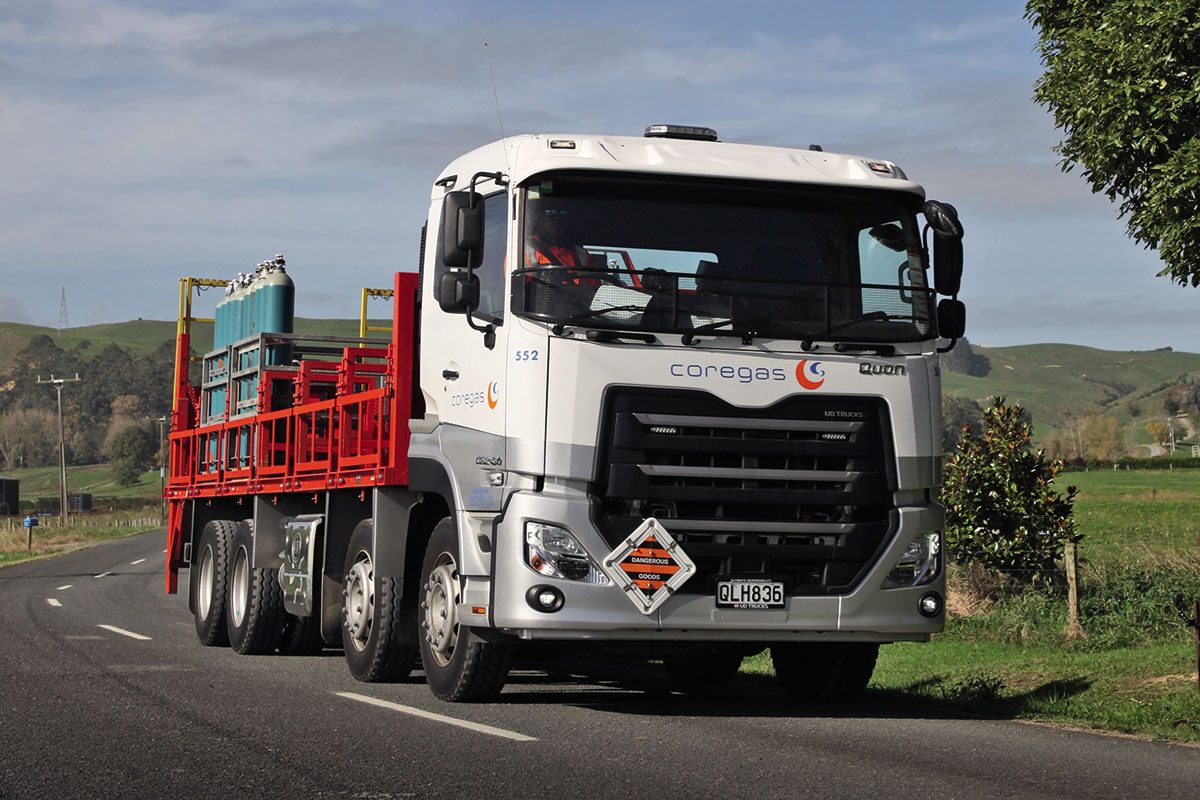
The 1990s was a period of significant growth for the company via acquisition. “We diversified into truck-mounted cranes, containers, a bit of air and sea freight, warehousing and shipping and barges along the way,” continues Alan. By 2004, Tom Ryan Cartage also had a presence in the South Island.
“The height would’ve been around the 2008 GFC, with 267 staff, four ferries and 180 trucks. But a real period of rationalisation followed that, a realignment in terms of how we balanced service and never saying no, with sensible business decisions: ‘Yes, we can do that, but under these terms and conditions,’” Alan explains.
And so the container division was divested to L.W. Bonney & Sons, the South Island operation to Northern Southland (which subsequently sold it to Toll), and the ferries were taken over by Sealink.
“It’s been a pretty good time since,” says Alan. Today, the company is home to 110 staff, with a truck fleet of just over 100, split between its two Onehunga premises in Alfred Street and Galway Street. “Galway Street is currently the workshop, serviced by a team of nine mechanics who do a lot of our R&M. It was Tom’s original premises. We moved into Alfred Street in 2002. It’s the old McIvers yard. We added the Approved Transitional Facility (ATF) for container packing, unpacking and warehousing.”
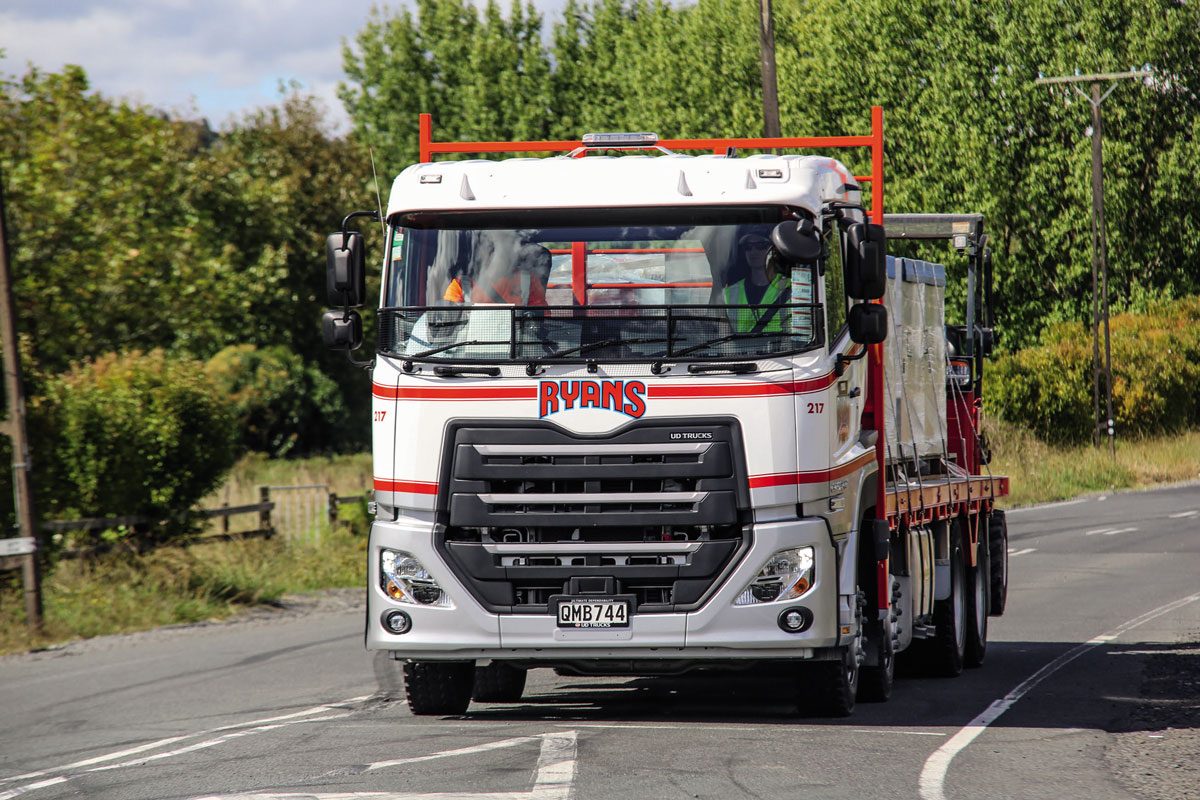
Operating in the big city
In addition to warehousing, Tom Ryan Cartage today has a general freight division, an air and sea freight-transfer division and a truck-mounted crane division. By far the biggest area of the business, the fleet of 65 truck-mounted cranes mostly serves the city’s construction industry. While these are “the bread and butter”, comprising 65% to 70% of the business, they are also supported by a range of flatdecks, trombones and tipper units.
Palfinger is the crane of choice. “They consistently hit the mark, have excellent aftersales and have always been on the money with parts, crew and turnaround. They continue to perform, and we’ve always been pretty happy with them,” Alan says. The cranes are supplemented by two rigid units fitted with Moffett truck-mounted forklifts and four articulated low-loader units that carry Ausa forklifts.
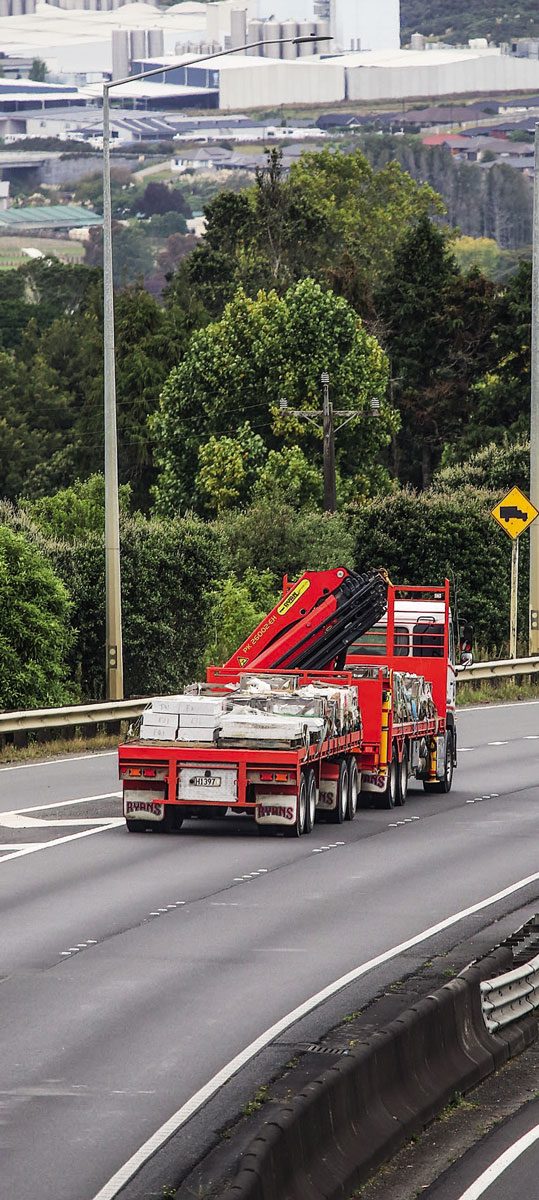
Why the rigid/Moffett, low-loader/ Ausa combinations? “The Ausas have a 2.5-tonne lifting capacity but weigh 4.5 tonne. As a traditional forklift, they’re more terrain-able and can efficiently and quickly unload 19 tonne of palleted product onto sites where cranes aren’t the right solution. But it’s a bloody artic unit running around Auckland … we get sent to places like Parnell with these things, and it’s ridiculous,” Alan explains.
“As rigids, the Moffett units are much smaller and more agile. We can get up so many more streets with these trucks. Yes, the artics give us more payload but can be a headache on the site. So, even if the Moffetts themselves are a little less capable on undulating terrain than the four-wheel Ausas, that mix is about right for now.”
By all accounts, Alan takes a no-bullshit approach to his role as GM, so when he makes a statement about plant, staff, industry or operation, you can believe he’s calling it like it is. He elaborates on the need for these different units coming down to having the right tool for the job in an increasingly complicated operational environment.
“If we could run everything as a truck and trailer, life would be simpler and more efficient. But we’re addressing the challenges presented by building sites in the city, and finding solutions has become harder over time, with development of the city … in-fill housing, brownfields developments have made it more difficult.
“There’s also been a lack of, or loss of, knowledge – the merchant sales force who used to go out and do a site inspection on these new sites and might have been a builder or in transport or had some operational relationship … that’s faded away.
“The other problem is every site is different every day, so your hazards and challenges change throughout the build, and in that sense, we rely on builders who know what’s going on – some are very engaged and aware and give great facilitation, they invest in positive outcomes for their sites. But there are still those who sub out everything, and the subbies don’t care how it all happens. So, we then take on this duty of care in how we operate with the likes of traffic management, when really, it’s a site issue.
“We’re always operating in that grey area of managing the situation around what’s operationally feasible without jeopardising safety. All too often it comes down to getting a more suited truck, and that’s where having those options comes in. In places like Herne Bay, our guys can be onsite mucking around for three hours at a time.”
But Alan adds that there has been a lot of progress from all role players. “Twenty years ago, sites didn’t want to know, but many of the builders have come along. Worksafe’s engagements with sites have improved their understanding of compliance and safety. Auckland Transport and consents from council and the changes to the building code did change the way we engage.
“Overall, I think safety is managed well across the industry. As an occupation, you’re about 13 times more likely to die per day trucking. Construction is the same … Our guys are on a truck, and then on a building site – you don’t get much more dangerous for an operator out there on their own. Yes, we’re introducing risk to a site, but at the same time, we’re attending sites that are full of risk. So it really is about that shared responsibility.”
But what about the trucks?
As one would expect of a metro-based haulier operating at city speeds and lighter weights, Tom Ryan Cartage has long had an association with Japanese trucks – historically Hino and, in more recent times, Isuzu.
“We had a good relationship with Hino and operated about 50 of them over the years. In time, we shifted to Isuzu. Their price points were similar for a long time but then Isuzu really came in aggressively. Their trucks were good for us. With the long decks on the crane trucks, we could get a bit more on. But having run about 30 Isuzus over the years, we found some persistent issues that became a problem in our operation. It wasn’t solely down to those issues, but they were among the pushers for us to consider other options,” says Alan.
Given the laws of natural progression, one would assume that meant a step into a UD showroom, and today Tom Ryan runs 16 Quon units from the brand.
“The relationship with Marvin Fynn [UD Trucks key account manager] has been good – and the others were good, too. But it’s just natural progression. At the moment, as those come up for replacement, the UDs are joining the fleet. Their price point was only a little higher, and they have performed very well out of the box, though we’re still relatively new in the relationship. While I focus on price and reliability, they offer a fair technological jump as well. For the drivers, it feels like a new adventure. The only gripe we’ve had moving to the UDs so far is the lower clearance on approach angles, especially with the hiabs at construction sites. And that’s a small thing,” Alan says.
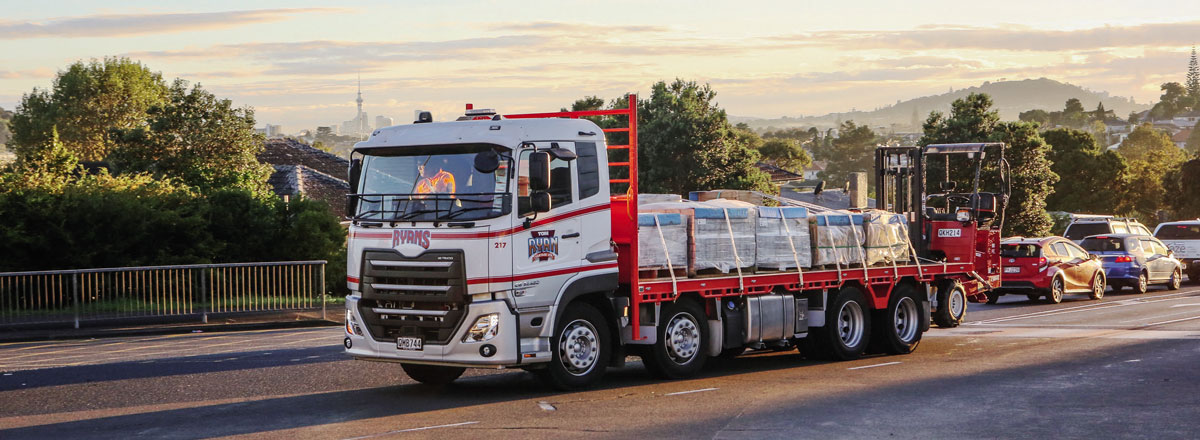

The oldest of the current UDs is a 2018 model that has covered 120,000km. “We have 20 years’ useful life from our trucks. If we see 1,000,000km on a truck after its 20-year life with us, it’s a big thing,” Alan says.
“We don’t do big Ks. On average, our trucks do 150km a day. Unlike most truckies who get paid for putting Ks on the clock, we get paid when not moving. We make our profit on site loading and unloading. So, again, that’s why we shop in the band of the market we do. We’d love to buy all Volvos or Mercs, but they’re 50% more. Our capital investment isn’t in the trucks – I’m happy to put a $400,000 crane on a $150,000 truck, for example … If someone were paying me to, I’d spend $300,000 on a truck, sure, but fundamentally, we get paid for lifting capacity.”
The newest of the 16 UDs in the fleet are five of the latest Quon models enhanced for the 2024 model year. The big talking points are greater safety spec, better fuel efficiency from the GH11/ESCOT-VI powertrain, and a bump in outputs across the board. Given the unique opportunity to get up close to a range of these new models with the same operator, we lined up the new Quon CG 32 460 and CG 32 430, each in a different business area, to see what’s what.
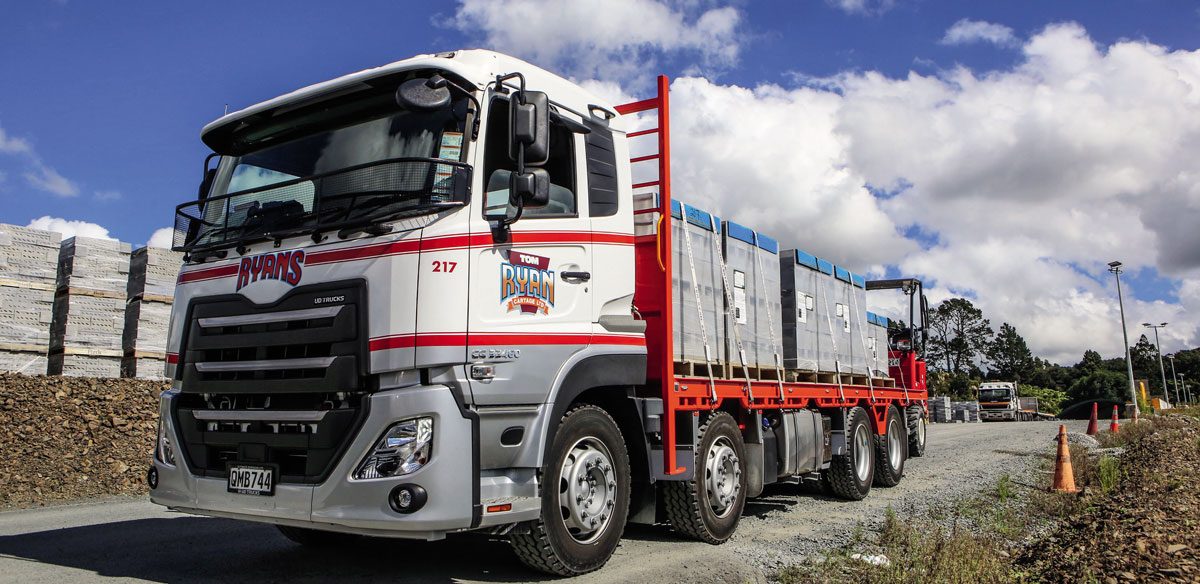
Trust in man, trust in machine
Truck No.217 is one of the two new 8×4 flatdeck Moffett units. Almost as fresh out of the box as can be, it had only been on the road for three weeks and covered just 2400km when we jumped aboard with driver Shashi Singh and took to the wilderness of West Auckland.
We first meet Shashi at 8am on a cool autumn morning outside a domestic building site in Avondale, the first of his four deliveries for the morning. The truck’s carrying 10.5 tonnes of blocks, bricks, pavers and tiles to be distributed to building sites in Avondale and Massey, with a drop-off at Bunnings New Lynn in between. With the three-tonne Moffett M8 NX on its rear, Shashi’s UD is good for a 15-tonne payload, or about 12 pallets.
As we’d find in the course of meeting Shashi, and fellow drivers Ritesh Chand and Jin Chung, the company’s culture is clearly one that resonates with its staff. A consistent theme in the way the drivers describe their jobs is that they’re empowered with the trust and autonomy to get on with it and get the job done properly. There’s a real sense of ownership. It’s clear in how Shashi operates, too.
His managers know that he’s good on the job, treats the gear as his own, and has an engaging manner with the customers, which comes as no surprise after more than a decade on the job – Shashi has been with Tom Ryan for 11 years and a master of the Moffett for 10, and boasts a 30-year driving career in total.
“Tom Ryan is only the second company I’ve worked for in New Zealand since I came here from Fiji in 2007. I don’t chop and change. Tom is a good lad, a good boss. We don’t get to see him much, but he knows every one of us,” he comments.
Shashi is pedantic about his work environment, coning-off the truck at all sides before lowering the Moffett, especially considering he’s forced to park on the other side of the road at this first drop. It’s a quick drop – only three pallets – but that doesn’t mean shortcuts are taken.
“Safety is a big thing. We’re out here doing this job on our own, on the road. Cars don’t stop for us and that makes it risky. We have to be very careful,” he comments.

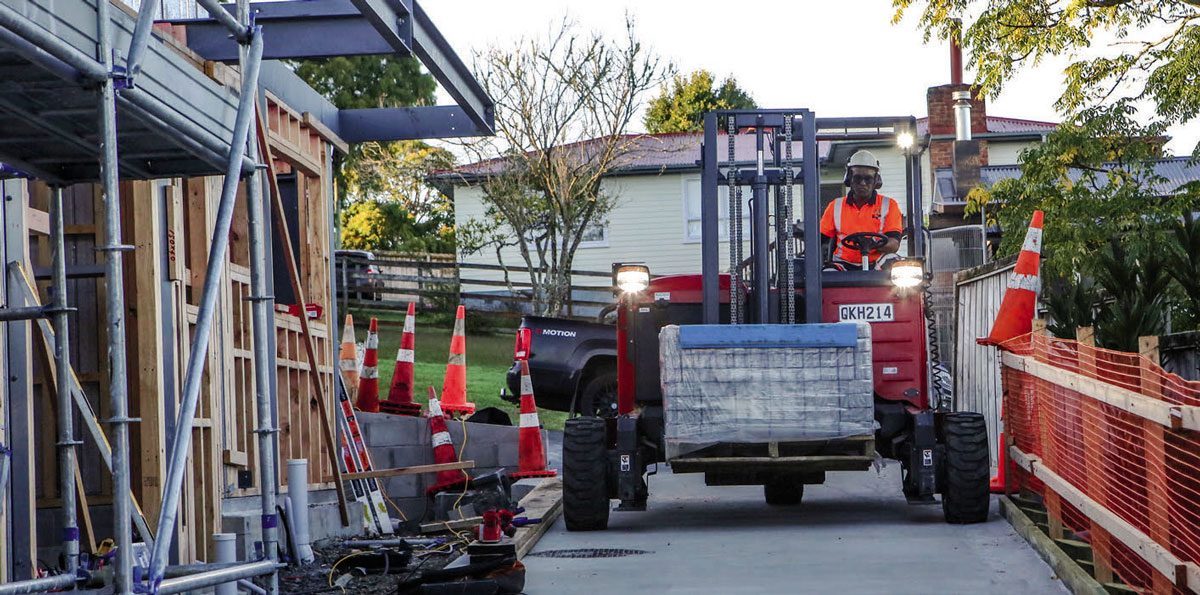
The consistent variance in building sites also requires a different set of skills on the Moffett, compared to hiab or traditional forklift operators. “You need to know the technique for driving them,” Shashi comments. “They can be tricky in the wet, on mud and loose metal if you’re inexperienced. We need a forkhoist licence, but some companies require you to have additional certification to drive the Moffett. We do refreshers every few years.”
By the time Shashi makes his last drop for the morning in Massey, his next job comes through from despatch, and we head south to Firth’s Hunua Quarry to collect a full load of blocks and pavers. The drive down Auckland’s western motorways in an unladen truck is nothing to talk about, but it allows us to explore the Quon’s enhanced active safety features. These are all intended to detect and mitigate potential road hazards. As standard, the enhanced Quon features UD’s Smart Traffic Eye Brake, Smart Blind Spot Information System (BSIS) and Smart Lane Change Support (LCS) on both sides of the truck, Smart Traffic Eye Cruise, and, optional, the Driver Alert System that monitors for driver fatigue.
“It’s a nice and easy drive,” Shashi says as he talks me through the features. “The cruise control with distance control maintains the pace to the car ahead, great on the highway. But to be safe when I’m not using it, I’ve set a speed-limit warning on the GPS too,” he adds. “Overall, the safety systems are really helpful.”
Having become familiar with the truck’s sensitivities, Shashi creeps up a little closer to the car ahead to demonstrate the UD’s Smart Traffic Eye Brake system. A loud, rapid acoustic warning fills the cab, and a warning is flashed on the driver’s display. If Shashi had kept the accelerator pinned, the UD would’ve applied the brakes to avoid a collision.
He comments that the BSIS and LCS systems are incredibly helpful, especially when it comes to pedestrians and cyclists around the truck. If a vehicle alongside the truck activates the feature, the truck issues a double beep and the indicator light in the A-pillar flashes. Again, a warning is issued in the instrument cluster.

About an hour later, we’re pulling out of Firth onto Hunua Road, with Shashi bound for a drop in Whitford. The roads heading north up the eastern fringes of Auckland offer a good amount of variance to see how the revised GH11 at 338kW (460hp) performs. While the power of this top model remains unchanged, torque output has gone up by 50Nm to 2250Nm (1659lb/ft), and it also comes in 100rpm sooner, at an even 1000rpm, and is maintained to 1250rpm. It’s still coupled to the ESCOT-VI 12-speed AMT, but there’s a new high-strength clutch and flywheel now making the connection.
Accelerating from a junction, the CG 32 460 pulls off in fourth and skips to sixth, eighth and 10th at 1500rpm, shy of the 1700rpm power peak. Acceleration and shifts are smooth, and soon we’re up to open road speed, and the ESCOT- VI selects 12th. Truck-only, at these weights, it’s easy going. Getting into the hills, it drops one ratio to maintain the pace.
“I like that the engine doesn’t race,” comments Shashi. “The previous truck was a 400hp Isuzu, and it had an 18-speed Roadranger, which I’ve only ever driven. This gets along perfectly on its own. I enjoy the higher power and I leave the gearbox to do its thing.”
Managing the pace is a four- stage engine brake, which is more than strong enough at these weights, even on the descents that require the most care.
Bottles on, bottles off. The gas-bottle trucks are simple but nifty. Dhollandia electric tail lift and raised walkway between the steel pallets makes moving them easy.
Giving it gas
Having experienced the construction-service side of the business (read more in Right People, Right Company, page 28), we used the opportunity to dip into the general freight side of Tom Ryan Cartage and experience one of the new CG 32 430 units on gas-bottle duty. The company has had a longstanding 12-year relationship with Coregas and operates 10 Coregas-branded trucks.
Ritesh Chand is the driver of No.552, which has just passed the 11,000km mark, covering Hamilton, Cambridge, Morrinsville, Te Awamutu and Te Kuiti, with the odd transfer to Tauranga. Ritesh is another seasoned employee, having celebrated seven years with the company, all that time on a Coregas Isuzu in which he covered 300,000km.
Like Shashi, Ritesh fully buys into the Tom Ryan culture. “I started at Tom Ryan and straight away went for a week’s training. Management trusts us and looks after us – they don’t bother us but sort out things on the spot if there are problems. Alan is good. He understands and has feeling for his drivers. But he doesn’t do bullshit; he needs us to be honest.
“I love this job. It can be physical, but I don’t mind. On a busy day, I can do 16 deliveries between 5am and 7pm. That’s more than 170 bottles, depending on size. A full load of bottles is around 13.5 tonnes,” he says.
Gas bottle trucks are simple but nifty units. The custom deck by Hamilton-based Dreambooster Engineering (new to the scene but good at what they do, says Alan) offers 10 locations for steel pallets, which are locked in place when the drop-down sides are raised. An elevated walkway down the centre of the deck keeps everything level and allows Ritesh to access the bottles he needs easily. An electric Dhollandia DH-VO 15 tail lift provides smooth, silent, easy lifting of the bottles during deliveries.


“I’m happy to load my truck, so I can know the weight and balance. The boys at Coregas strap the bottles to the steel pallets, and I forklift them on,” Ritesh comments. At site, the truck’s mobile scanner allows him to easily log each bottle as he moves from job to job. “I always do my best to finish a run so nothing hangs over to the next day. But some jobs can take up to 45 minutes if I have to do pressure testing.”
It’s much easier going today; we only have 68 bottles. When we meet up with Ritesh, he has already made his first drop at Fonterra’s Te Rapa facility. After a couple more drops in the area, it’s time to head for Morrinsville.
“Alan asked me if I wanted the UD or another Isuzu. I said I’ll try the UD,” Ritesh explains as we make for the Hamilton Bypass. “I like it. It’s only 430hp, but it’s comfortable and fine on the highway with a full load.”
In the enhanced Quon range, the GH11 in 430hp guise offers up 7kW (10hp) more power than its 420hp predecessor, as well as an additional 100Nm torque. Peak outputs are now 316kW (430hp) at 1600rpm and 2000Nm (1475lb/ft) from 950 to 1450rpm.
In achieving higher outputs from the GH11, UD has redesigned and improved the cylinder block, cylinder head, injection system, pistons, crankshaft, connecting rods, lubrication system and auxiliary drive. The results are not only improved outputs, but a claimed 2.5% improvement in fuel efficiency. Indeed, Ritesh’s CG 32 430 is returning 2.8kpl, slightly better than Shashi’s fresh-out-the-box CG 32 460 at 2.5kpl.
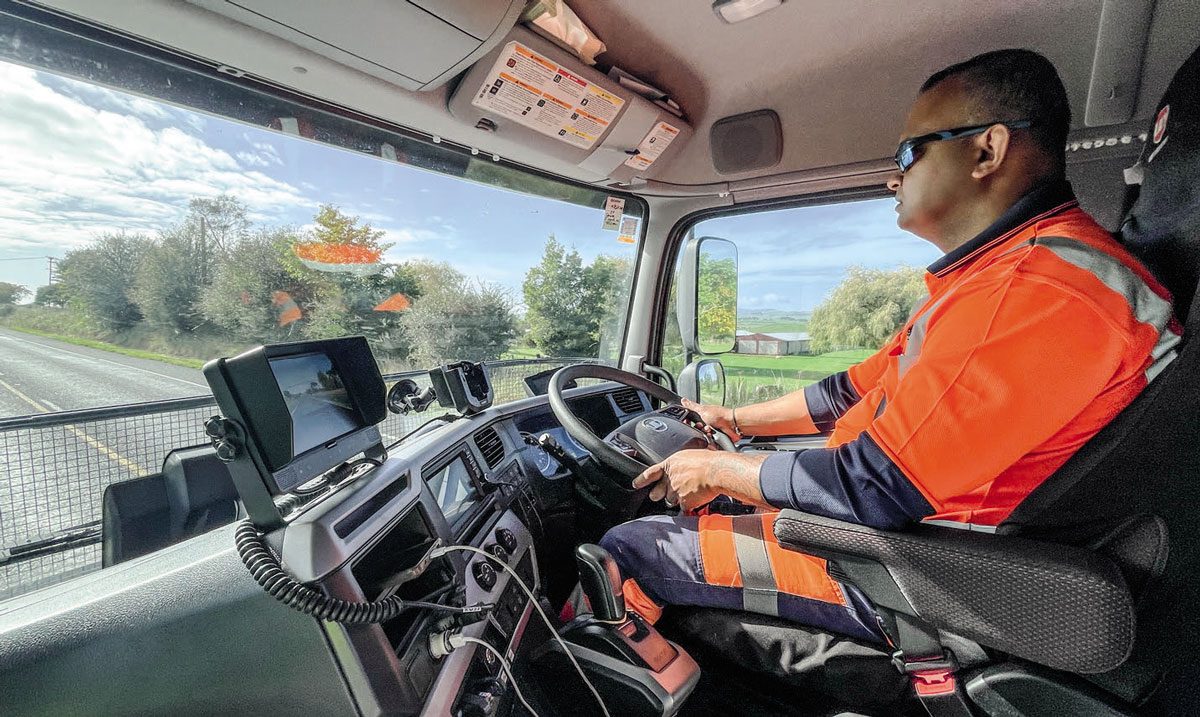
Unfortunately, as Ritesh is running very light, the opportunity isn’t quite there to assess the 430’s performance. Regardless, there’s no doubting the engine and gearbox combo is as competent as it is in the 460, and the exhaust brake is well overqualified for the Coregas life. “I only use it up to stage three; the full braking force is too strong in this application,” says Ritesh.
In an application such as a gas-bottle truck, one can never have too much safety. Ritesh is as complimentary as Shashi about the enhanced Quon’s active safety systems. “It’s good to have all the new tech and safety … that these trucks are at the same level as modern cars. I find it all quite handy. People complain about these types of systems being too sensitive, but it all depends on how you drive,” he comments.
Both the lane departure warning and Smart Traffic Eye can be disengaged (the latter only temporarily), and as we traverse rural Waikato’s narrower roads, the lane departure rarely issues its soft rapid beep warning.
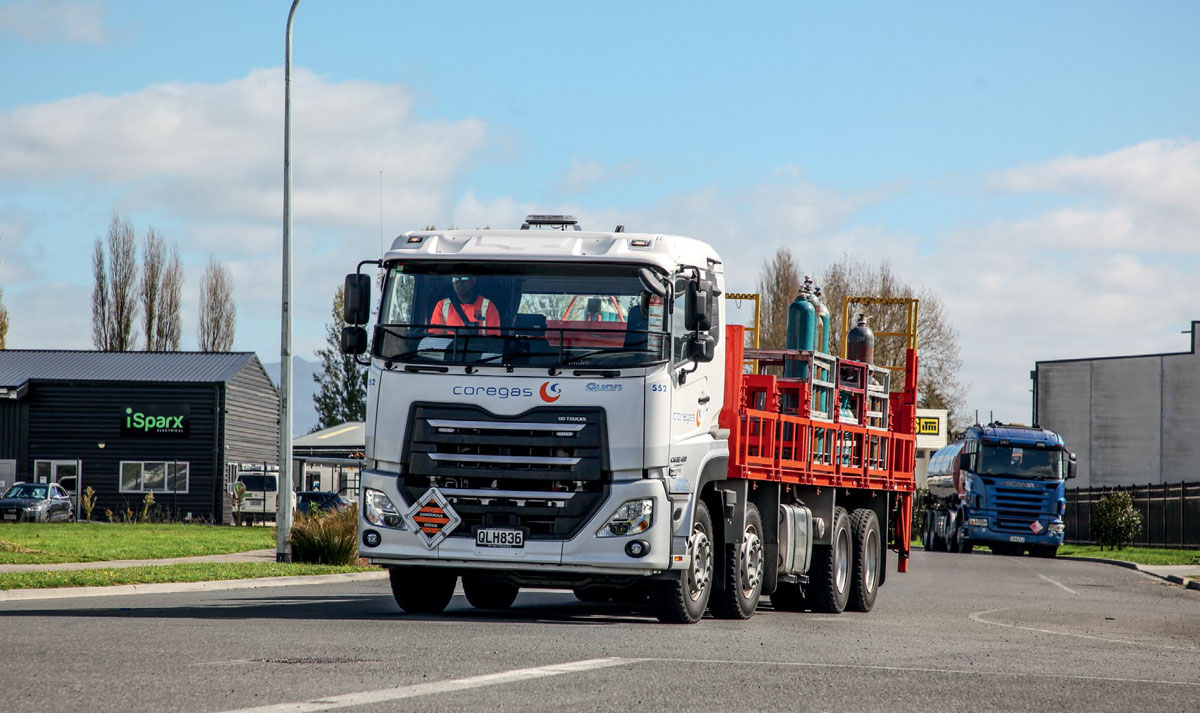
Small things have a big impact
Just last month, UD celebrated 20 years and two generations of the Quon. The second generation, all-new Quon, launched in 2017 and so has been with us for a while. With this latest enhancement to the range, UD has improved the Quon in the areas it matters most …
There’s little changed in the interior. Just about the only noticeable difference is the new five-inch colour LCD driver information display. Build quality is top drawer, with more than enough space and storage. Comfort and ride quality remain very good, and refinement levels are in the Euro-truck neighbourhood – both the 430 and 460 returned an average 69dB interior noise reading.
Importantly, though, UD is continuing to deliver where it matters most – on the job.
“So far, UD is hitting the mark and knows when to say a truck is or isn’t suited to a particular application. We put a lot of trust in them … we’re specialists in moving freight, not truck specialists. We want trucks that go from A to B consistently and reliably, with driver comfort and safety,” Alan comments.
The last time we featured a Quon on the cover was March 2022, a pre-enhancement CG 32 460 belonging to Mt Maunganui- based McLeod Hiabs, a company also big on cultivating a positive culture. After a few days in the company of the team at Tom Ryan Cartage, we can’t help but think the Quon is the type of truck that easily finds a home among companies that value good culture.
That’s not to take away anything from other brands or operators, but can it be just coincidence?
SPECIFICATIONS
UD Quon CG 32 430 AS and CG 32 460 AS
| Tare: | 430 – 11,580kg / 460 – 14,230kg (load certs.) |
| GVM: | 32,000kg |
| GCM: | 430 – 55,000kg / 460 – 60,000kg |
| Wheelbase: | 5885mm |
| Engine: | 430 – UD GH11TC / 460 – UD GH11TD |
| Capacity: | 10.8L |
| Power: | 316kW (430hp) at 1600rpm / 338kW (460hp) at 1700rpm |
| Torque: | 2000Nm (1475lb/ft) at 950–1450rpm / 2250Nm (1659lb/ft) at 1000–1200rpm |
| Emissions: | pPNLT/Japan2016 – Euro-6 equivalent |
| Transmission: | UD ESCOT-VI AT02612F AMT |
| Clutch: | High-tensile carbon steel. 300mm x 90mm x 8mm |
| Front axle: | Reverse Elliot I-Beam |
| Front-axle rating: | 14,200kg |
| Front suspension: | Parabolic leaf spring with shock absorbers |
| Rear axle: | Single reduction, hypoid gear, cross locks. 4.13:1 |
| Rear-axle rating: | 20,000kg |
| Rear suspension: | Eight-bag electronic controlled air suspension |
| Brakes: | Disk. ABS with EBS |
| Auxiliary braking: | Four-stage exhaust plus engine compression brake |
| Additional safety: | Passive – Side door beams, front underrun protection system (FUPS), SRS driver airbag. Driver’s side seat belt with pre-tensioner. Steering wheel and column with impact absorption. Active – Smart Traffic Eye Brake System, Traffic Eye Cruise Control with auto stop and Driver Initiate Go, lane departure warning system, electronic stability control, automatic hill start assist, lane change support, blind spot information system |
| Productivity: | ECO mode, ESCOT roll, acceleration limiter, soft cruise control, Nenpi coach, idle shutdown |
| Fuel / DEF: | 400L / 50L |
| Wheels / Tyres: | 8.25in x 22.5in / 275/70 R22.5 |
| Electrical: | 24V |
| Cab exterior: | Four-bag air-suspended cab with four dual-acting shock absorbers and dual automatic height-control valves. Heated and electrically operated main mirrors. LED low-beam headlamps, LED daytime running lights |
| Cab interior: | Air-suspended driver seat. Remote central locking with immobiliser. Five-inch colour driver information display. Fully automatic climate control. 6.5in touchscreen infotainment with Bluetooth and USB input, wifi-enabled, built-in gyro, GPS, four camera inputs, hardwire reverse camera input with CAN interface |
Special thanks
Thanks to Alan Spilhaus and the team at Tom Ryan Cartage for being so accommodating and going out of your way to get us into three trucks for this feature, and for sharing your insights into your operation and just what it takes to cultivate a good culture.
Thanks to Shashi Singh, Ritesh Chand and Jin Chung for having us along, telling us your stories and showing us what you do.
Thanks to Marvin Fynn for providing us the details on the enhanced Quon range and to the team at Sime Darby Motors for your ongoing support of our publication.
Quick reads from Test
Read more
The right man for the job
0 Comments29 Minutes
Legendary ambition
0 Comments36 Minutes
Hard Fought!
0 Comments40 Minutes
Postal Trifecta
0 Comments29 Minutes



















